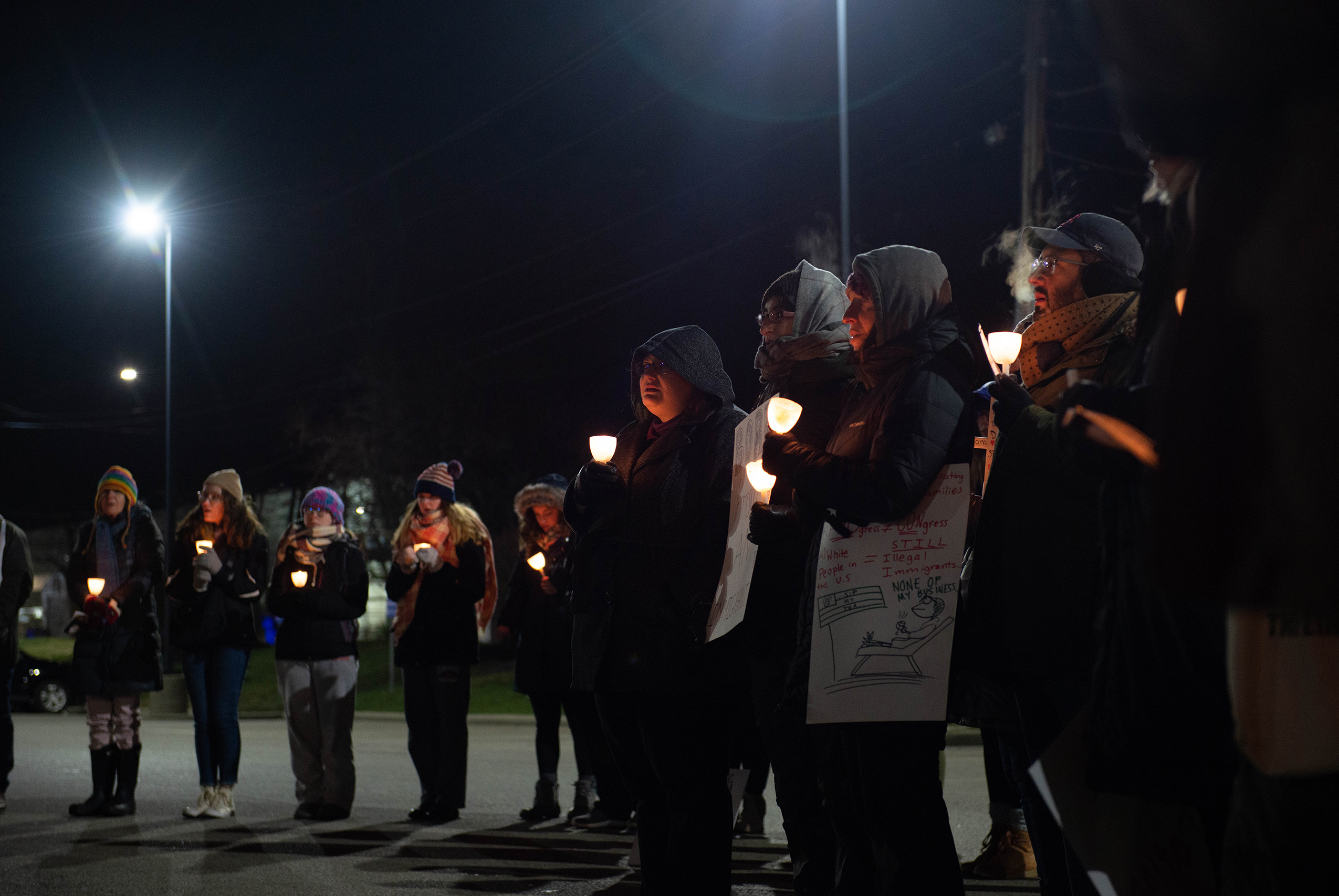Let's Talk Human Rights

Keeping Vigil: Reflections on Human Rights at the Border
By Bridget Graham '22
Standing outside of the Butler County Correctional Facility in 20°F weather, I couldn’t help but think for a moment of the hieleras, frigid holding cells where men, women and children are often held for days by immigration authorities on the Southern border, with only a thin foil blanket for warmth against the cold concrete. Migrants and refugees detained there often spend hours or even days in these cells. After an hour of standing at the vigil, I got to jump in my car and blast the heat until the feeling returned to my fingers. I got to call my mom and talk to her about how excited I was to see her over break. The thousands of migrants and refugees detained in detention centers like Butler County aren’t so lucky.
On Dec. 10, in honor of International Human Rights Day and the 71st anniversary of the signing of the Universal Declaration of Human Rights, we gathered together in solidarity for those detained in inhumane conditions and separated from their families.
Though it’s no longer on the front page of every newspaper, the humanitarian crisis at the border has not gone away. The current administration has bragged about a 75% drop in migrants apprehended at the border, a result of forcing would-be-asylum seekers to wait in Mexico for their claims of asylum to be processed, while going without basic human needs like clean drinking water and sufficient clothing. All asylum seekers are at risk of being targeted for extortion, kidnapping, and rape at the hands of cartels and other criminal actors.
Seeking asylum is a legal process that is guaranteed by several international human rights laws, including the Universal Declaration of Human Rights, the 1951 UN Convention Relating to the Status of Refugees, and multiple federal laws in the U.S. However, recent enforcement policies by the Trump Administration has made it almost impossible to claim asylum in the past three years. Due to obstacles faced by asylum seekers in Central America, the borderlands, the Immigration and Customs Enforcement (ICE) detention centers, and the immigration courts, it is extremely difficult to enter the US legally. Many of these changes have happened quietly, without the usual fanfare that surrounds the President’s controversial policies, like building the wall or the 2017 travel ban. As Alysa Medina, a law student who spoke at the vigil asked, “Have these policies ended? Or has the media just turned away?”
The truth is the latter. Twenty four people have died in ICE custody since 2016. The conditions in detention centers remain abysmal, and families are still being separated. In the face of this disturbing reality, it is easy to feel helpless,but there’s a lot a single person can do, and a lot more that can be done by working collectively. Below are a list of resources with actions you can take or organizations you can support right now and into the future:
LOCAL
- Advocates for Basic Legal Equality (ABLE) works directly with civil rights cases across Western Ohio, including with a focus on Agricultural Worker and Immigrant Rights that affect migrants in the Dayton area most directly. As a nonprofit, their goal is to help their clients “achieve self reliance, and equal justice and economic opportunity.”
- The Miami Valley Immigrant Coalition is an interfaith group focused on humane immigration reform through the values shared by people of different faith backgrounds. They directly address issues faced by migrants in Dayton through education, direct service, and providing resources to the Dayton community.
NATIONAL
- Catholic Social Teaching argues “we are one family under God,” and in response to this teaching, the US Conference of Catholic Bishops provides resources under its program, Justice for Immigrants. Ranging from stories of migration to guides on dealing with immigration enforcement, this project emphasizes the inherent dignity of immigrants in the Catholic faith.
- Certain constitutional protections, including due process and equal protection, apply to citizens and immigrants alike, and the American Civil Liberties Union has taken on protecting the civil rights of immigrants in both the public and private sphere.
- Supporting immigrant and refugee neighbors is at the heart of Welcoming America’s mission. Their website provides a list of concrete action items you can do to help immigrants right now, from writing your representatives to hosting community dialogues.
- The Nation’s Take Action Now initiative provides weekly action items on various critical issues. Signing up for the newsletter allows subscribers to receive three meaningful actions to take each week.
- Focused exclusively on immigrant rights, the The National Immigration Law Center & Center for Law and Social Policy has been dedicated to protecting and defending the rights of low-income immigrants since 1979.
- Amnesty International provides an international perspective to Refugee and Migrant Rights as well as being one of the largest organizations providing research, government advocacy, human rights education and activism around all issues of human rights, including migration.
- For even more specific and effective ways to take action for immigrants, Ms. Magazine compiled a list of 10 action items in response to reports from the border that demand attention.
Bridget Graham is a sophomore Human Rights Studies and Political Science major and an intern for marketing and social media at the Human Rights Center.
